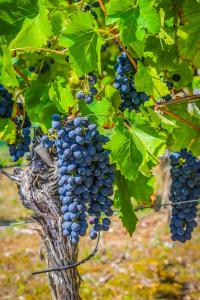
“Grafted In”
In horticulture, the term grafting means the joining of a section of one tree (the scion) into the trunk, or life force, of another tree (the rootstock) with the result of them becoming one tree bearing the characteristics of both. The scion determines the fruit type, while the rootstock influences tree size and other such characteristics. This technique is used to propagate specific fruit varieties, as most fruit trees don’t come true to seed, and cuttings don’t root easily.
Grafting in the New Testament refers specifically to the Gentiles being grafted in through Christ to the inheritance of Israel. Let me propose that it may also refer to the individual who is saved by grace and who then becomes a part of the “body of Christ” (1 Corinthians 12), or who is metaphorically grafted into the vine of John 15.
Why Graft the Grape Vines
According to Decanter, grafting “allows grape vines to express the desirable varietal characteristics of the scion in the fruits, while developing or keeping the root system of the rootstock”
The article continues, “In the 1860s, when new botanicals were being brought from the New World to Europe, a tiny louse, later named as phylloxera, hitchhiked to Europe in live vines from America. Since its arrival, the pest ravaged all of Europe and almost wiped out plantings of Vitis vinifera, the wine species of the genus Vitis, in this part of the world and beyond. After various failed attempts to eradicate the phylloxera, scientists discovered that the domestic vines from America are naturally resistant to the insect, which feeds on the roots.” Grafting the European vines into the American vines gave resistance to the insects.
According to Grafted Sellars, wine from grafted vines is greatly improved, not only because of resistance to pests, but also because of flavor profile, vineyard management, and overall quality:
Flavor Profile
“Grafted wines often display a more consistent flavor profile because they benefit from the precise combination of grape variety and rootstock. The controlled vine growth and disease resistance can result in wines with intense and predictable flavors, making them appealing to both winemakers and consumers.
“On the other hand, non-grafted wines may exhibit more significant flavor variation due to the unpredictability of vine health and development. While some non-grafted wines may offer unique characteristics, they can also be more susceptible to disease-related flavor inconsistencies.”
Vineyard Management
“Grafted vineyards are more manageable and sustainable. Winemakers have greater control over disease prevention, yield, and vine health. This predictability in vineyard management allows for better planning and resource allocation.
‘Non-grafted vineyards may require more extensive pest and disease management and additional attention to soil conditions and vine health. This can lead to higher maintenance costs and potential risks.”
Overall Quality
“The overall quality of grafted wines is often considered higher and more consistent than non-grafted wines. This is primarily due to the benefits of disease resistance, improved vine vigor, and better climate adaptation.
“While non-grafted wines can be of excellent quality, they may require more meticulous care and attention to achieve the same level of consistency and resilience.”
The Grafting Process
So, now that you know why, here is a simplified step-by-step guide to how to graft the vines:
- 1. Choose a compatible rootstock and scion:
Select rootstock and scion varieties that are compatible within the same fruit species (e.g., apple scions on apple rootstocks). - 2. Prepare the graft:
Make clean, matching cuts on both the rootstock and scion using a grafting knife. - 3. Join the graft:
Align the cambium layers (the green layer just under the bark) of the rootstock and scion, and secure the graft union tightly with grafting tape or wax. - 4. Protect the graft:
Seal the graft union with grafting wax or compound to prevent drying out and protect against insects and diseases. - 5. Provide care:
Place the grafted tree in a sheltered spot, keep the graft union moist, and monitor for new growth.”
Grafting Us Into the Vine
Simplified, here is our microcosm: We choose (free will) to be joined into Jesus Christ, our Savior, and we want to be compatible with Him and His will for our lives. We do our best to match Him, and He helps us along by making the “cuts.” The original healthy grapevine that produces much is Christ. Through reading the Word, prayer, and His great love, we are perfectly joined and provided with what we need to become more and more like Him. Years down the line, by grace, we look enough like Him that the cut can not even be found. We not only become part of His body, but we are protected from disease and attack. Our very existence in this life becomes more palatable and manageable. We live dependant upon Him, and He provides for us.
Psalm 103:1-4 promises:
“Praise the Lord, my soul; all my inmost being, praise his holy name.
Praise the Lord, my soul and forget not all his benefits: who forgives all your sins and heals all your diseases, who redeems your life from the pit and crowns you with love and compassion.”
As we acclimate and grow in our relationship with Christ, the very Spirit that nourishes Him, nourishes us. As the sap passes through the vine and into the branches, so the Spirit passes through Him and into us. We are His and He is ours. Hallelujah!
Amidst the joy and promises, there is a warning:
“I am the true vine, and my Father is the gardener. He cuts off every branch in me that bears no fruit, while every branch that does bear fruit he prunes so that it will be even more fruitful. You are already clean because of the word I have spoken to you. Remain in me, as I also remain in you. No branch can bear fruit by itself; it must remain in the vine. Neither can you bear fruit unless you remain in me” (John 15:1-8, the words of Jesus Christ).
Bearing Fruit
Bearing fruit is necessary to remaining in the vine. And what is our fruit? It may be what the Bible terms “the fruit of the Spirit” evident in our lives: “The fruit of the Spirit is love, joy, peace, patience, kindness, goodness, faithfulness, gentleness, and self-control” (Galatians 5:22-23). It might also be the fruit of our actions, performed for His service: “we…have not ceased praying for you and asking God to fill you with the knowledge of his will in all spiritual wisdom and understanding, so that you may live worthily of the Lord and please him in all respects—bearing fruit in every good deed” (Colossians 1:9-10). In addition, it could be the fruit of our prayers and requests as we live in fellowship with Him: “If you remain in me and my words remain in you, ask whatever you wish, and it will be done for you. This is to my Father’s glory, that you bear much fruit, showing yourselves to be my disciples” (John 15:7-8). Colossians 1:11-12 speaks of being “strengthened with all power according to his glorious might” for “all endurance and patience with joy.” It also mentions “giving thanks to the Father who has made us worthy to share in the inheritance of God’s people in the kingdom of light.” In essence, we are dependent on God for power, and our ability to exist in that power, through our connection to Him, along with the joy of thankful service.
I understand, and this is the voice of experience, that I cannot navigate this world doing good on my own. My own good is not good for much anyway. All my “righteousness is as filthy rags.” Thank You, Jesus, for grafting me into You where I am safe and useful!
God bless you and graft you into Himself.
.
G












